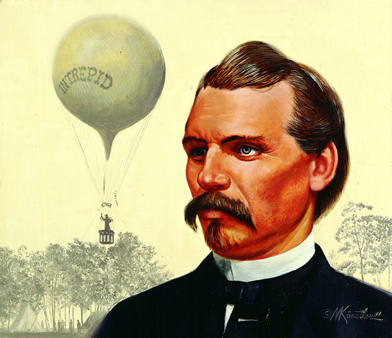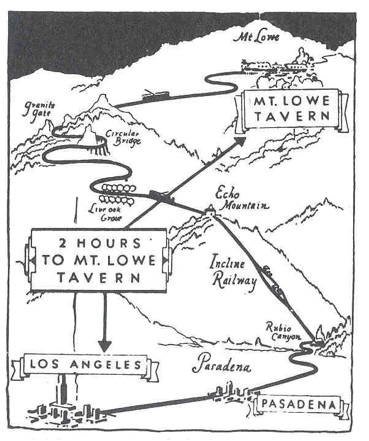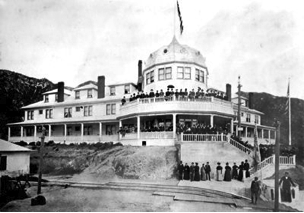Part One
Prof. Thaddeus S. Lowe
(1832 - 1913)
“The most shot at man
in the Civil War”.

Prof. Lowe and his gas balloon “Intrepid”
This story begins in June of 1861 with the Confederate Army marching toward the Union’s Capitol located on the banks of the Potomac River. A young man by the name of Thaddeus Lowe stood before President Lincoln with an idea to save the Union Army from defeat. "The future of America lies in the air! The airship is a weapon that will help us win this war”. His voice rang with enthusiasm; his eyes were the eyes of a dreamer. The President Lincoln replied, "You are asking me to equip the Union Army with balloons to observe the movements of the enemy. I should think, Mr. Lowe, that balloons would make splendid targets."
The young man shook his head: "Balloons are not easily shot down, Mr. President. They would be fixed at altitudes beyond the range of enemy guns. There would be nothing to shoot at, except the almost invisible mooring ropes. The balloons would be equipped with telegraph wires, and our field headquarters would receive instantly reports of enemy movements. Not only that, sir, but our own artillery fire could be directed from the air."
"Mr. Lowe," said the president, "I have always been a great hand at playing hunches. This time I have a hunch that something may come out of this idea of yours. I may get cussed out for doing it, but I am going to appoint you Chief Aeronaut of the United States Army."
On June 17, the specially equipped balloon named “Intrepid” ascended on tethers to a height of 500 feet, carrying Prof. Lowe and representatives of the American Telegraph Company. Using telegraph equipment aboard the airship and cables that ran along one of the rigging wires to the ground and from there to the War Department and the White House, Lowe sent the world's first telegraphic transmission from the air.
The Intrepid with Lowe aboard continued to float mockingly just above effective range of shell fire, while the air reconnaissance was launched at a sufficient distance behind the Federal lines to make capture unlikely. The Confederates were furious. There were no effective counter measures against the "Yankee gas bags." The Confederates posted a circular offering a standing reward of one thousand dollars in cash and military promotion for any Confederate soldier who destroyed one of the observation balloons. Many soldiers shot at Prof. Lowe, but the reward was never earned.
Soon afterwards, Mr. Lowe founded America’s naval aviation by persuading the Union Navy to buy and equip a war ship to act as a platform for launching an observation balloon high above the Potomac River.
When the war ended, Thaddeus Lowe's army and navy adventures were soon forgotten by the public and he went unrewarded by the military. However, his prediction that wars would be won in the air eventually became true. Lowe’s balloons of 1861 grew wings in the 20th Century
Editor’s Comments:
Part Two will trace Mr. Lowe’s ballooning adventures before the Civil War while Parts three and four will tell of his life as a railroad and hotel builder. Follow this dreamer’s many historic accomplishments.
Part Two
Prof. Thaddeus S.C. Lowe
“His Early Years”
Thaddeus Lowe was born August 20, 1832 in Jefferson Mills, Coos County, New Hampshire. As a child he had an insatiable appetite for learning, but was limited in the amount of time he had for school. His farm chores only allowed him the three winter months to attend Common School at Jefferson Hills, two miles away. The school had no books, but like Abraham Lincoln, Thad would spend his evenings in front of the fireplace reading books loaned from his teacher’s personal library.
At the age of eighteen Thad attended a chemistry lecture by one Professor Reginald Dinkelhoff featuring the phenomena of lighter-than-air gases, specifically hydrogen. When the Professor requested a volunteer from the audience, an eager Thaddeus jumped to the fore. Dinkelhoff could see the interest in his eyes and after the lecture offered him a job as an assistant pilot for the show’s balloon rides. Lowe did so and after two years upon the professor’s retirement bought out the show and proclaimed that he was “Thaddeus Sobieski Counlicourt Lowe, Professor of Chemistry.”
By the late 1850s Lowe had become a foremost balloon builder and continued his lucrative business as a showman giving balloon rides to passersby and fairground attendees. In 1859 Lowe began the construction of a mammoth balloon to be named the City of New York. Meanwhile he espoused the theory of transatlantic flight to many who had stock market interests in Europe.
Before the first test flight of this massive 103-foot diameter balloon, which included a 20-foot diameter 8-man canvas covered gondola, Lowe had renamed it the Great Western, on the advice of newspaperman Horace Greeley. Lowe’s balloon flew successfully on June 28, 1860, from Philadelphia to New Jersey, but on his first attempt at a transatlantic launch on September 7, 1860, the balloon was ripped open by a high wind. Lowe then waited for favorable weather the next spring.
A second test flight, was made from Cincinnati and was to return him to the eastern seaboard. For this flight he used the smaller balloon Enterprise. His flight took off on the early morning of April 19, 1861, two days after Virginia had seceded from the Union. The flight misdirected him to Unionville, North Carolina where he was put under house arrest as a Yankee spy. Having established his identity as a man of science, he was allowed to return home where he received word from Secretary of the Treasury Salmon P. Chase to come to Washington with his balloon. The American Civil War permanently ended Lowe's attempt at a transatlantic crossing.

Lowe's intended flight from Cincinnati
shown in red. Actual flight in blue.
Part Three
Thaddeus S. Lowe
“His Activities after the Civil War”
In March of 1863, the Union Army put a Captain Comstock in charge of the Balloon Corps and reduced Lowe’s pay. Lowe tendered his resignation and by August the Corps had ceased to exist. Having had enough of the war, Lowe bought a farm near Valley Forge and continued with his scientific endeavors with hydrogen gas. Here Lowe patented a process by which high volumes of the volatile fuel could be made from passing steam over hot coal. This volative fuel revolutionizing home heating and lighting along America’s eastern seaboard. He also patented an ice making machine which completely changed the cold storage industry. He even discovered that gas burning through a platinum mantle produced a bright illumination (as later found in the Coleman lantern). With these patents Lowe was able to amassed a great fortune. For his achievements Lowe received the coveted Elliott Cresson Grand Medal of Honor for the Invention Held to be Most Useful to Mankind.
In 1890, at the age of 58, Lowe retired and moved his family westward to California, finally settling in Pasadena where other millionaires were living. Pasadena was noted for it fresh air, the scenic San Gabriel Mountains and for its closeness to the warm Pacific Ocean. Just west of downtown Pasadena Lowe built a 24,000 square-foot mansion. Not happy with retired life, he started a water-gas company, established several ice plants, and organized a Los Angeles bank.
In 1891 Thaddeus Lowe met David McPherson, a civil engineer, who had drawn up plans for a scenic mountain railroad from Pasadena to Mount Wilson on the crest of the San Gabriel Mountains. Lowe was quick to recognize that a mountain railroad would be a great tourist attraction for Pasadena and put up the money to start construction.
Unable to obtain all the rights-of- way to Mt. Wilson, the two men redirected their railway toward Oak Mountain via the Echo promontory. Oak Mountain was later renamed Mount Lowe by Andrew McNally, a friend and map printer from Chicago, who was then living in Altadena, a town adjacent to Pasadena.
On July 4, 1893, Lowe opened the first section of his scenic seven mile electric streetcar railway. At Rubio Canyon the passengers were transferring to a 2,800-foot-long incline for a steep ride to the top of Echo Mountain. There they were transferred again for another streetcar ride to the Mt. Lowe Tavern.

MOUNT LOWE RAILROAD
Part Four
Thaddeus S. Lowe
“The Hotel Builder”
Mr. Lowe arrived in Pasadena in 1890, just four years after this California town had incorporated and the same year as the first Tournament of Roses Parade. He was one of the first wealthy Easterners to move to Pasadena to escape the cold winters and enjoy the warm California climate. Some of the other millionaires coming to Pasadena included Adolphus Busch, co-founder of Anheuser-Busch, brewer of Budweiser beer, William Wrigley Jr., maker of Wrigley’s chewing gum, and David Gamble, son of consumer product titan James Gamble of Procter & Gamble fame. Mr. Lowe and the others were also attracted by Pasadena’s beautiful surroundings. Virtually every kind of flower was in bloom during the winter months while the mountains offered opportunities for hiking, hunting, and sight seeing.
Mr. Lowe proceeded to build his six story mansion on Orange Grove Blvd., which later became known as “Millionaire’s Row” and the starting place of today’s Rose Parade. His home boasted of having an observatory on the top level. It can be said that Lowe was among the first to recognized that California’s clear skies were ideally suited for making astronomic observations. Lowe later moved his telescope to the top of Echo Mountain.
At the same time that Thaddeus Lowe was building his mansion, he was also constructing the Mount Lowe Railroad to the summit of the San Gabriel Mountains. The Railway opened on 4 July 1893, climbing the steep Lake Avenue and crossing the Poppyfields of Altadena into Rubio Canyon. The first stop was the Rubio Pavilion, a small 12-room hotel built by Lowe. From there the passengers transferred to a cable car which climbed the Great Incline to the top of the Echo Mountain promontory.

The Echo Mountain House
Atop Echo stood the magnificent 70-room Victorian hotel, the Echo Mountain House which rivaled the Hotel Del Coronado in San Diego as a luxury facility. Only a few hundred feet away stood the 40-room Echo Chalet which was ready for opening day. The complement of buildings on Echo included an astronomical observatory, car barns, dormitories and repair facilities, a casino and dance hall, and a menagerie of local fauna. Passengers could then transfer to another trolley line, the Alpine Division, which would take them to the upper terminus at Crystal Springs and Ye Alpine Tavern, a 22-room Swiss Chalet hospice with a complement of amenities from tennis courts, to wading pools, to mule rides.
For the seven years, during which Lowe owned and operated the railway, it constantly ran into hard times. The fares did not cover the interest on the construction money borrowed at 10 1/2% interest, and the opening day fare of $5.00 would not remain attractive to the greater public. Lowe went into receivership one or two times before losing his ownership of the railway in 1899.
Today nothing remains of the Mount Lowe Railroad or the hotels built by Thaddeus Lowe. In 1900 the Echo Mountain House burned down. It was grossly underinsured and was never rebuilt. In 1909, an unseasonable electrical storm and flash flood tore out the Rubio Pavilion. In 1936 the tavern on Mount Lowe burned to the ground from an electrical fire. At the onset of World War II, the dismantling of the railway was contracted to a scrapper who stripped the railway of all salvageable materials. In 1959 the Forestry service began a rampage on the leftover shells of the buildings, dynamiting everything into history as "hazardous nuisances.”
What of Professor Thaddeus Lowe? Lowe died at his daughter's home in Pasadena, California, at age 81 after a few years of failing health. He was buried at Mountain View Cemetery in Altadena, California, Next to him lies his wife Leontine who died but a year later. There are no grandsons to carry on the name of Lowe, but many of the children and grandchildren of the daughters carry the Lowe name as a middle name.
Editor’s Comments: This concludes the series on the work of one of America’s great visionaries. Lowe’s lifetime accomplishments in the fields of chemistry, aviation, refrigeration, astronomy and railroad building are truly remarkable. For 10 years his mountain top hotels brought thousands of tourist to southern California just for a view from Mt. Lowe. In June 2009 I climbed Mt. Lowe and photographed the event which will eventually become an article in this Journal.
